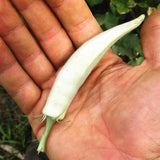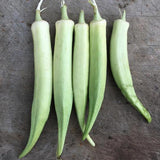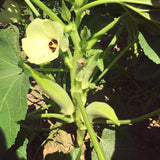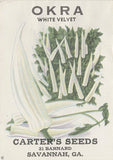White Velvet Okra
Abelmoschus esculentus
Loaded with long, white, velvety, and spineless fruits, this is a gorgeous and delicious variety eaten fresh off the plant, cooked, or canned. White Velvet Okra has been an important part of Southern foodways (particularly in Alabama) for over 100 years. It was made commercially available in 1890 and was widely popular due to its tender fruit lacking spines, and beautiful contrast to the colors of tomato based soups, or sometimes in fresh salads, pickles, gumbos, or by itself. Like many important regional food plant varieties, the scaling up of globalized agriculture brought a flooding of the market of cheaper, more standard and generic green okra varieties being grown farther away, and so tender heirloom is extremely rare these days.
This variety was given to William Woys Weaver in the mid-1990s. White Velvet Okra has been designated by Slow Food as an outstandingly tasty, culturally important, and endangered heirloom from Alabama, Mississippi, and Louisiana, and is listed in their Ark of Taste as a way to invite everyone to take action to help protect it.
Days to Maturity: 65
Seeds per pack: 40
Germination rate: 93% on 10/31/2025
Planting / harvesting notes
Sow seeds of this heat-loving plant indoors 2-3 weeks before transplanting, which should happen several weeks after the last frost, or when soil temperatures stay above 65 degrees Fahrenheit. Soak seeds overnight for quicker germination, and plant 3/4" deep. Space 18" in rows 12-18" apart. Beds should be at least 3' apart as plants tend to bush out widely. Okra likes fertile, well-drained soil with added compost.
Seed keeping notes
Okra is insect pollinated. Isolate different okra varieties by at least 1/8th of a mile (or up to 1/2 mile if you are truly concerned about seed purity) to avoid unwanted cross pollination. Allow pods to grow large and turn brown and woody (your neighbors may look at you funny). When you can hear the seeds rattle, harvest the pod and allow it to dry further on trays in the sun in a dry place. Remove seeds and use breath, wind, or fans to remove bits of chaff.













